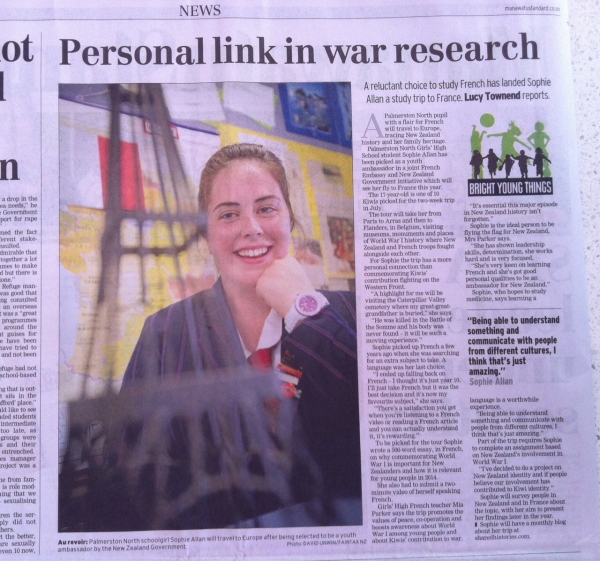Salut à tous!
I would like to start off by thanking the Awapuni Rotary and Milson Rotary Clubs from Palmerston North for their very generous donations towards the cost of the Young Ambassadors trip. It is much appreciated, and I look forward to speaking to them about the trip and my project outcomes.
On the 18th of March, the Manawatu Standard published an article about the Young Ambassadors Tour. I have included a picture of the article above. There is an important correction I would like to make. My great-great-grandfather has a memorial at the Caterpillar Valley Cemetary, rather than a burial.
Last Friday I met with Axel de Maupeou from the Palmerston North City Council, and his colleague Adrian Turner. I was put in touch with Axel by members of the Awapuni Rotary club. They said he would be a good person to get in touch with in regard to learning about WWI. Not only did he end up being helpful in that respect, but Adrian and himself said that they would be able to help me promote my final project to Palmerston North later in the year! This is fantastic news, as hopefully the more people who know about the project the more people will actively commemorate the centenary.
Axel was telling me about a New Zealand born doctor called Sir Harold Gilles who was involved with reconstructing faces of seriously wounded soldiers. I had been reading about Gilles work, and other WWI doctors efforts, which inspired me to change my project. I would now like to base it around the Medics of WWI, and what it was like for them. I would also like to compare what it would be like for NZ army doctors today, if they were to encounter tragedy like WWI in the coming years. The Linton Army base is a 10 minute drive from where I live, so I believe I could easily interview Army Medical Staff as part of my research.
I have recently been reading books and watching films and documentaries about the lives of soldiers in WWI. A particular book I found useful was a graphic novel called 'It was the War of the Trenches' by Jaques Tardi. It combined stories of the trenches with realistic comic illustrations to give the effect of the conditions soldiers on both sides of the front had to deal with. I have also recently seen 'All Quiet on the Western Front', an oscar winning film made in 1930. It told the tale of young German soldiers who discovered the war wasn't all glory and gratification. This had a profound impact on me as it made me realise that most soldiers involved in WWI, despite who they were fighting for, were just serving their country, hoping that the war would end with minimal bloodshed and loss.
That's all for now,
Sophie ![]()
Latest from Sophie Allan
Media
2 comments
-
Comment Link
 Saturday, 19 April 2014 22:53
posted by Ruth Bourchier
Saturday, 19 April 2014 22:53
posted by Ruth Bourchier
je veux dire 'sa mâchoire' !
-
Comment Link
 Saturday, 19 April 2014 22:51
posted by Ruth Bourchier
Saturday, 19 April 2014 22:51
posted by Ruth Bourchier
Sophie, tu as fait énormement de progrès en trouvant des personnes pour t'aider et te soutenir dans ton projet. Le changement de direction me semble très intéressant. Je me rappelle quand j'étais petite, chaque jour, en rentrant de l'école j'ai dû passer devant la maison d'un soldat blessé au visage pendant la deuxième guerre mondiale. Je l'ai trouvé epouvantable, et il me faisait très peur parce que la partie inférieure de son visage avait été gravement défiguré et il lui manquait une bonne partie de son mâchoire. Un chirurgien esthétique qui arrive à reconstruire surtout le visage d'un soldat lui rend un service inestimable pour son avenir.
Bonne continuation!

